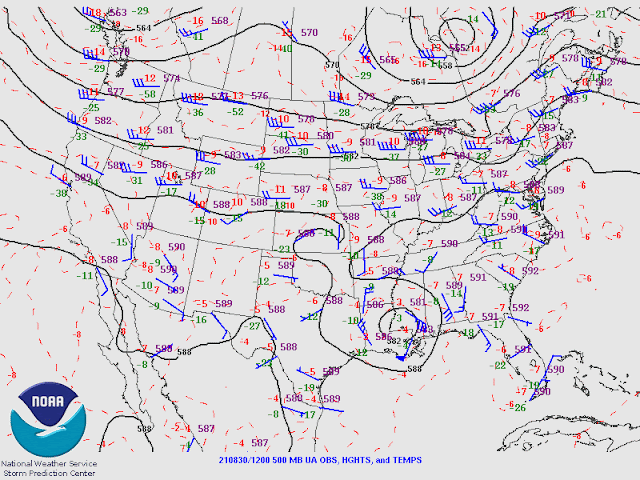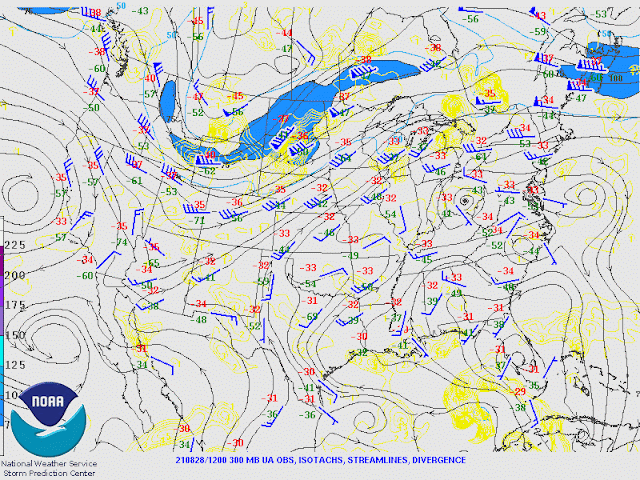Previous Forecast
Some locations of western Arizona got hammered with up to 4" of rain, according to Q3 estimates. A few weak storms moved through Tucson during the late afternoon/early evening. Early morning activity developed over western Pima/southern Maricopa, also producing heavy rain.
The model forecasts were generally accurate on locations but way too low on precipitation amounts. They all missed the heavy precipitation in La Paz County.
Discussion
The 500mb map has the anticyclone centered somewhere over northern NM resulting in a favorable southeasterly flow. A broad IT is located over far NW Mexico with two shortwave/MCVs near Vegas and SW of Phoenix. There is a residual low-level circulation left from Nora, just off the coast of Sinaloa. Thunderstorms are underway offshore, and maybe it will regenerate a little.
The 300mb map has the upper low moving slowly towards the state resulting in strong upper divergence. This is obviously helping the ongoing activity in SW Arizona and around Puerto Penasco, where strong storms are underway.
The Yuma sounding had 50mm of PW, but the lower troposphere was somewhat worked over, probably from the earlier activity. There was 1150 J/kg of CAPE, but it is elevated at 750mb. Tucson isn't any better as there is only 360 J/kg of MLCAPE. The wind profile is taking on a transition-type look with veering winds. There isn't enough directional or speed shear for supercells, but enough for some storm organization.
Phoenix looks about the same as Tucson, with minimal MLCAPE. Both are saturated above 700mb, and with such a wet atmosphere, any CAPE is probably enough for storms, especially with the upper divergence.
InitializationsIt's going to be a challenge to get a decent initialization today, for sure. Clouds are quite thick this morning, but satellite trends show a gradual decrease. The 6Z GFS did a reasonable job with both clouds, storms, and the various inverted troughs. The 9Z RR was missing the far NW Sonora activity, probably due to not having much of a cyclonic circulation initialized there. Other than that, it was OK. The 12Z RR also lacks the storms and associated MCV but did have an IT located near Puerto Penasco. It has too much activity west of Phoenix. The 12Z NAM did manage to initialize storms and associated weak MCV, but the storms were a bit too far north. It managed to initialized clouds OK. Suominet is still having issues with missing stations, but there are some available in Arizona. There are minimal errors at these sites, including the NAM. The end result is there is no good initialization, but none of them are terrible.
Day 1
The one certainty for today is that there will be plenty of moisture! The issues are how much heating there will be as well as the impact of the approaching trough.
CAPE is forecast to be moderate to high over much of southwestern and southcentral Arizona this afternoon. It's low elsewhere, but as mentioned earlier, sufficient for storms, just about anywhere due to the support of the upper trough.
The early afternoon Skew-T diagram indicates CAPE has increased at Tucson, with over 1300 J/kg. The wind profile also looks good, with low-level shear and quite strong easterly steering flow. What is even more interesting is the wind profile now has a decent amount of directional shear. Thus storms are likely to be organized, with the potential of some mini-supercells.
As would be expected, the various runs vary widely on the details. Still, generally, most develop showers and strong to severe storms by the early afternoon over southwestern and far south-central Arizona.
In areas that get some sun, from satellite imagery are eastern/central Pima, Pinal, and eastern Maricopa Counties, big storms are expected by later in the afternoon.
Despite 50mm of PW (or more), Phoenix only manages ~700 J/kg of CAPE. The wind profile is good with low-level shear and mid-level directional shear. At least in this run, there is a cap on top of the multiple shallow mixed layers, which may keep deep convection from forming.
Yesterday, it looked like southeastern Arizona wouldn't see too much activity, but today's runs tell a different story. Most develop widespread activity this evening.
The main threat today/tonight is very heavy rain and flash flooding. A few storms could produce isolated severe winds due to wet microbursts. The four-panel QPF has the heaviest rains over south-central and southeastern Arizona. Many runs have a few areas over 3", and maybe as much as 6"!
Rain and some thunderstorms continue into the early morning hours for much of the eastern 1/2 of the state.
Day 2
The California trough starts to move into Arizona during the morning hours, with continued upper divergence providing support for deep convection. (12Z tomorrow)
It appears there will be another round of storms for southern Arizona as Tucson manages to recover somewhat as CAPE is around 800 J/kg. The atmosphere is saturated below 400mb so, any precipitation is likely to be very heavy.
Many runs develop scattered storms over southern Arizona during the morning hours.
Activity moves east during the afternoon hours.
Parts of eastern Pima County could see an enormous amount of rain. Many of the 48h 4-panel plots have some areas receiving more than 4" of rain, with the outlier WRFRR run with some 8" amounts! This has the potential to be a major flash flood event.
The 15Z WRFRR QPF is similar to many of the earlier runs with widespread 1" amounts and isolated amounts around 6".
As the upper trough passes through Arizona, temperatures increase significantly above 500mb. Moisture also decreases, but it's still quite wet below the inversion. Phoenix manages 1100 J/kg by late afternoon, thus there is still some potential for a few storms.
Some of the WRFRR runs do develop some storms for the Phoenix area during the evening hours.










































































